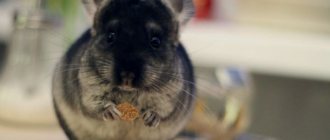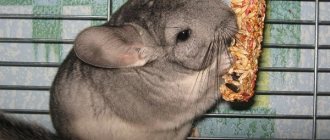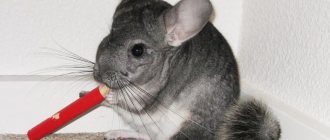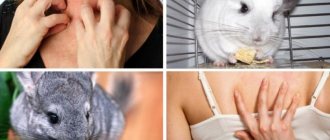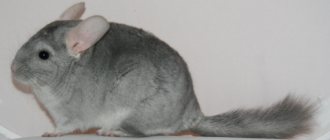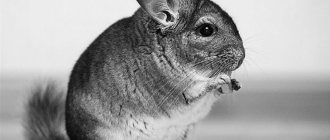History of the breed
British breed cats were bred in England. Although cats were bred by continental Europeans, the animals were named after Great Britain. The name emphasizes the similarity of the color of the cat's fur with the color of the chinchilla.
There are 2 versions of the origin of the British chinchilla. According to one of them, cats were brought to the British Isles by the Romans. This version gives grounds to assert that this breed is one of the most ancient.
According to another version, cats were bred by the British, methodically crossing animals to get the desired result. For mating they used Persian and gray British cats. The breed was officially introduced in 1889.
The first individuals had a gray color, which was called silver color, later golden chinchillas appeared.
Prohibited Products
Persimmons are prohibited for feeding. This fruit, useful for humans, is rich in iodine, which is contraindicated for animals. In addition to iodine, persimmons contain a lot of sugar and astringents, which will lead to constipation.
It is not recommended to give chinchillas and beets.
The root vegetable is healthy, but has a laxative effect. In rare cases, small pieces of beets can be given for constipation. Any type of cabbage leads to severe gas formation. Chinchillas love to feast on tea rose petals - they taste pleasant and have an attractive aroma. If flowers are grown in your own garden, there is no danger, but it is better not to give store-bought ones. They contain a lot of pesticides and chemicals that can cause serious poisoning.
When preparing tree branches for the winter, it is worth remembering which species are dangerous and unsuitable for feeding. Branches of which trees cannot be harvested:
- Apricot,
- white acacia,
- Beech,
- Ash leaf maple,
- Common buckthorn
- Cedar,
- Chestnut,
- Branches of any citrus species,
- Cypress,
- Elderberries,
- Cherries,
- Cherries,
- Branches of any coniferous species,
- Holly,
- Hydrangeas,
- Juniper,
- Common maple
- Myrta,
- Oleander,
- Plums.
Branches of stone fruit trees (cherry, cherry, plum, and so on) are dangerous because they contain a dangerous cyanide compound, as a result of the breakdown of which hydrocyanic acid is formed in the chinchilla’s body. If you feed an animal with such twigs, you can get not only severe poisoning, but also the rapid death of your pet.
Prohibited products also include any type of honey, as well as store-bought cottage cheese and fermented milk products.
Not all breeders know that chinchillas should not be given leaves, stems and flowers of indoor plants. Most of them are poisonous to the animal and very often cause death.
It is also not recommended to give any food from a person's table. Everything that is normal and familiar, even useful for people, for a chinchilla becomes the cause of digestive problems, allergies, obesity and other serious diseases. The animal will never refuse tasty and aromatic food and can eat a piece of cake, cheese, meat or fish. However, such food is not normal and familiar to the stomach of a furry pet. And the possible consequences are very sad.
Description
British cats have a round muzzle and wide cheekbones. The animals have a rather large body. The eyes are large, expressive, of various shades of green. The nose is slightly flattened. The ears are small, the fur is thick and long. The neck is short. The limbs appear short due to the long fur on the belly. The pads are powerful and round.
Chinchilla cats tend to be overweight and are easy to overfeed. British chinchillas can hardly be called elegant and graceful. It's more like a cute little bundle of warmth and beauty.
Males are larger than females, the weight of an adult cat reaches 7 kg. Cats weigh around 4 kg. After castration, males gain weight and can weigh 10 kg or more. Females after sterilization weigh up to 8 kg.
The average life expectancy of a British chinchilla is 10-15 years. With good care, a pet lives 20 years.
Focusing on sounds
Like cats, chinchillas are better at accepting names that contain whistling and hissing sounds (i.e. з, с, щ, з, ч, ж). By the way, it’s easier for the owner to pronounce such names.
Quite often, owners (especially young ones) name a chinchilla after a movie, book or cartoon character. Sometimes a nickname can be chosen in honor of a city or other geographical feature. Sometimes a pet is called the sonorous name of a musical idol. There are also cases such as names in honor of a car brand.
Color
Experts note 3 main types of chinchilla color:
- golden;
- silver;
- silver shaded.
Less common are marbled, tortoiseshell, fawn, tabby, harlequin, bicolor, and cinnamon cats.
The golden chinchilla cat is less common than its silver relatives. This species has a reddish color on the back, sides and tail. The neck and belly are creamy.
Silver pets are white and 1/3 black. Silver shaded – white with fur darkened by 1/8.
What is the price
The silver chinchilla cat breed is included in the middle price category. The cost of a kitten ranges from 30 thousand rubles. up to 70 thousand rubles. There are 3 price categories:
- pet class - chinchilla kittens have a low cost and are purchased as pets, since they have flaws in appearance and are not intended for showing and breeding.
- Breed- and show-class - these cats have a high price category and are intended for exhibitions and selection.
To summarize, we note that you should get a pet like a silver chinchilla without hesitation, since the cat will decorate any home and easily make friends with children and other animals.
Relationship with the owner
Cats quickly find a common language with their owner and play with children. The British are prone to apathy. The chinchilla cat loves to be given attention and entertained.
If the owner is busy and cannot pay attention to the golden or silver chinchilla, it becomes offended and begins to get bored. The animal loves to be nearby when the owner is reading a book, watching TV, or doing homework. He will sit in your arms exactly as long as he wants.
The cat is imposing, allows itself to be stroked and scratched behind the ears. But he does not tolerate familiarity. As soon as the owner begins to squeeze the cat or tries to pat it, the pet expresses dissatisfaction. They are the kind of animals that allow themselves to be loved and set their own rules.
Is it possible to keep these two animals in the same room?
A properly adapted chinchilla and cat can get along even in tight spaces. Typically, cat owners look down on domestic rodents. But at the same time, they treat chinchillas condescendingly, preferring not to pay attention to them. The situation is good - there is peace and quiet in the house, no one is hunting anyone, no one is fighting with anyone.
However, there are often cases when rodents themselves provoked the cat into active actions. Rodents succeed in awakening a dangerous predator in their domestic pussy when the animal lacks a sense of proportion and its behavior crosses the boundary of what is acceptable. The most common reasons for starting hunting:
- Excessive curiosity - when a small animal tries too hard to get to know the cat better.
- Rudeness is when a rodent that has become accustomed to a new territory demonstrates disrespect for the other inhabitants of the house and tries to show itself as the boss.
Article on the topic: Allergy to chinchilla in a child and an adult, are there hypoallergenic chinchillas?
Regardless of what exactly provoked the hunt or just a conflict between the animals, the owner can only place the pets in different rooms and make sure that they do not intersect again.
Mobility
Aristocratic chinchillas would rather lie imposingly than rush around the house. Although they are not averse to frolic, but in moderation. There are no special transition stairs for them, no ropes are laid out so that they have somewhere to spend excess energy. These are pets that decorate the house.
In Western countries, an owner is considered bad if a domestic cat has less than 2 toys. There is no need to count the number of cute objects our cats have, but the animal will feel better if it has its own toys. Stores offer active and educational games for cats. The British are considered to have intelligence. Devices that develop logic have been developed for them. Toys will have to be updated periodically.
Other “bad” habits
Most chinchilla habits have a natural origin. Why does a chinchilla eat its own excrement and jump? Because it is so inherent in nature. The structure of their legs is designed for jumping and protection from predators, and due to the droppings, the intestinal activity of the animals is improved.
Falls over on its side
It is rare, but it happens that a chinchilla sleeps on its side simply because this is its favorite comfortable sleeping position.
There are other relatively harmless causes of such “fainting”:
- pregnancy;
- exhaustion and exhaustion;
- overheat.
We sleep as we want!
Rolling onto one side should be a cause for concern if it is accompanied by other symptoms of various pathologies:
- Stroke – aggression, inappropriate behavior, severe thirst, decreased appetite.
- Diseases of the cerebellum - vomiting, decreased chewing function, strabismus, no appetite.
- Rabies - when the animal falls on its side, it twitches.
Grits his teeth
There can be many reasons for teeth grinding. Most often, the pet simply grinds down its teeth. If, in addition to the fact that the chinchilla grinds its teeth, nothing strange is observed in its behavior, then there is no reason for concern. If you suspect your animal is unwell, it is better to contact a veterinarian.
When the grinding is accompanied by a lack of appetite, it is necessary to check the health of the pet - perhaps he was poisoned by table salt, chemicals or a poisonous plant. In case of poisoning, the following are also observed:
- diarrhea;
- dilated pupils;
- paralysis;
- excessive salivation;
- thirst;
- blue mucous membranes.
Gnaws the cage
- Reasons why a chinchilla chews its cage and how to eliminate them:
- Boredom. It is necessary to give the animal walks, add toys and crawl spaces.
- Natural necessity. Sometimes it is enough to simply place other dental simulators in the cage - tree branches, mineral stones, wooden toys.
- Defensive reaction. If a chinchilla sheds its fur and chews on its cage, it means it wants to free itself. To make your pet friendly, you need to use various taming methods.
When choosing a cage, you must immediately ensure that your pet can chew on it. A cage made of hard wood (beech, etc.) is ideal.
Let me out of here! I want to go for a walk!
Kittens
British breed babies do not have clearly defined coat and eye colors. In childhood, the fur of a golden chinchilla cat can be distinguished. The animal is finally formed by the age of 1.5 years. In an adult animal, the color of the fur and eyes is visible, and it no longer changes with age.
For kittens to develop normally, food must be age appropriate. It is better to use ready-made dry and wet food. Kittens should not be fed cow's milk. For them, it is better to use goat’s milk or diluted in a ratio of 1:3 (where 3 parts are cow’s milk).
They were abandoned, but now they are a family cats2friends
Let's get acquainted, we are a family cats2friends
: https://instagram.com/cats2friends and each of us has our own story, which we will tell about in the following posts.
goldfish comet - Gagarin.
Write about whom you would like to know more about.
Bathing
These cats don't like to swim. To keep the coat in good condition, British chinchillas are treated with dry shampoo. The composition is applied to the wool, rubbed in, then combed out with a brush. The powder removes dust, cares for hair, and creates volume. The procedure is performed 2 times a year. Shampoo is selected depending on the shade of the coat. A golden chinchilla will not benefit from a product intended for a pet with silver fur.
British chinchillas do not tolerate regular bathing well. If it is not possible to use dry shampoo, be prepared for a negative reaction from your pet to water. To create maximum comfort, a cloth is placed under the cat's paws. The animal clings to the lining with its claws, does not slip and feels more calm.
When bathing your Briton, make sure that the shampoo does not get into the eyes and ears.
Cage interior
Inside, the animal’s cage is filled with important elements necessary for the healthy functioning of chinchillas.
Retreat house
Be sure to install a house inside the cage. You can buy it at a pet store or make it yourself using wood as a wall material. Such a refuge inside the cage is necessary so that the animal can retire, hiding from the views of others.
DIY chinchilla house
Tray
Chinchillas use ordinary cat litter boxes as toilets. To save space inside the cage, purchase a corner option. Of course, your pet won't know how to use the litter box correctly at first, but over time you can get him used to it. You just need to be patient.
Chinchillas very quickly get used to visiting the litter box.
How to train a chinchilla to use a litter box
Sand bathing suit
A mandatory procedure for keeping a chinchilla's fur in order is bathing in seliolite sand. Using this exotic procedure, the animals remove accumulated dirt from their fur. In the wild, chinchillas used volcanic dust, which can easily be replaced by sand at home.
What does a purchased chinchilla swimsuit look like?
You can make a swimsuit yourself. Suitable for this:
- large plastic container;
- a water bottle with a hole cut in the side;
- plastic canister;
- small basin.
Take care to secure the product tightly to the wall of the cage, as intensive bathing in the sand by animals can lead to the bathtub turning over.
You can make your own bathing suit for chinchillas
The sand inside such a bathing suit can be either anti-inflammatory or regular. In the first case, you will have to change it for a new one approximately once every two months, in the second - once every two weeks. If this is not done, microorganisms will develop inside the sand, which will then settle in the chinchilla’s coat and cause dermatitis and other skin lesions.
Drinking bowl
A drinking bowl for chinchillas is purchased at a pet store, not just any kind, but a special one for rodents. The device is hung at a height of 10 centimeters from the base of the cage. Only boiled, clean water is poured inside.
Drinking bowl for rodents
Feeder
This device is available in two options:
- floor;
- hinged.
If you prefer the first option, choose a heavy product, since the animal often turns over light containers, spilling water on the bedding.
Ceramic feeder for chinchillas
Mounted feeder
How to line the bottom of the cage
The floor of the cage should be covered with thick carpet. Walking on such flooring, the chinchilla will protect its paws from damage on the slatted floors of the cage.
Coniferous sawdust can serve as bedding.
Unable to use this material, opt for soft sawdust or commercial pine litter for cat litter boxes. It will not only draw out various odors, but also disinfect chinchillas’ paws, protecting them from various diseases.
Hygiene
The chinchilla cat quickly learns to use the litter box. Sand or filler is changed frequently. If the animal feels that the litter is stale, it will find a corner and relieve itself there. Don't scold the British in this case.
Ears and eyes require special care. The ears are cleaned with a cotton swab moistened with warm water once a week or as they become dirty. The eyes are wiped with a cotton pad soaked in warm water. You can use wet wipes for this if they do not contain fragrances or other synthetic additives. They can harm your cat's mucous membranes.
The claws are cut off as needed using a nail clipper. If they peel off, it means that the diet requires correction and the chinchilla does not receive the necessary nutrients. To keep claws in good condition, make a scratching post at home.
Chinchillas and cats: friends or enemies?
Features of animal care
It is difficult to predict the behavior of different species of animals if they find themselves in the same territory. Cats are jealous of their territory, on which they are accustomed to walk wherever they please. On the other hand, they are characterized by jealousy of other pets. Chinchillas are kept in cages or special display cases, sometimes allowed to run around and frolic around the apartment.
Cats may become interested in rodents by trying to reach them through the bars of the cage. Even if the mustachioed one is not going to eat the chinchilla, but is just playing, this can become a lot of stress for the rodent. Therefore, owners should carefully monitor the behavior of cats and try not to leave them alone with eared cats. Even if the cat is peaceful and does not attack the chinchilla, it is better to allocate two different rooms for keeping them.
How do they get along: is it possible to live together?
A cat is a predator, and a chinchilla is a rodent, and according to the laws of nature, the former must hunt the latter. If a chinchilla is brought into an apartment where a cat has been living for a long time and feels like the rightful owner of the territory, serious problems may arise. Purr is against such a neighborhood; in the worst case, he will pursue “prey”. If a kitten gets into a house with chinchillas, then the advantage will be on the side of the rodents, which may be larger and faster than the baby, then the owners will have to protect the mustachioed one.
Felinologists note that a large active cat and a small chinchilla are an extreme option. Sooner or later the purr will get to the rodent.
There are cases when both types of animals do not show any interest in each other, each of them lives its own life. It is better to get cats and chinchillas at the same time when they are still small. The animals will grow and play together. Then the likelihood of comfortable coexistence will be much higher. Many owners claim that rodents get along well with cats and even get along well with dogs and parrots. When they all get together, they arrange funny games and “races” in the apartment.
Article on the topic: Do guinea pigs stink or not, the reasons for the smell from a rodent
Preparing and introducing animals
In a house where a cat already lives, it is worth preparing for the arrival of a new pet with special care. The space needs to be arranged so that the animals are comfortable and each has a separate corner. If the feline representative has a favorable attitude, then the territory of their stay may be common. The chinchilla and the cat will be able to run and play together, and since rodents do not eat meat, the cats will not have to fight with them for food. Despite this, each pet should have its own separate “house,” and owners should not leave animals frolicking together unattended, even if they have become friends. It all depends on the first meeting.
Actions of owners when meeting animals for the first time:
- Show the cat the new inhabitant of the apartment and make it clear that they will live together.
- Open the cage and remove the chinchilla from it.
- Let the mustachioed animal sniff, avoiding sudden movements and holding it tightly in your hands.
- Carefully monitor the reaction of the purr so that in case of danger, remove the rodent in time.
- Give the feline a chance to sniff the chinchilla's cage.
- Pet both pets, letting them know that they are equally loved.
If the acquaintance is unsuccessful, the animals will need separate living quarters. The chinchilla will have to be kept in a cage located in a separate room, where the cat should not enter. It is important that the place for the rodent to walk and play is safe and that a domestic predator cannot get there.
Nutrition
To keep your pet's coat in good condition, the British chinchilla needs special nutrition. The best option is dry food. It is chosen depending on the age and gender of the pet.
Castrated and sterilized animals require special food. Manufacturers produce food for such animals. If feeding is homemade, it should be low-calorie, since processed animals are famous for their large appetites and are prone to becoming overweight. In addition, their hormonal levels are disrupted and this is taken into account when feeding.
If you plan to use homemade food, the chinchilla’s menu should include cereals, meat, fish (sea, as river fish can have parasites), and vegetables. Raw meat should not be given to cats. The product may contain worm eggs, and the animal will become infected with parasites.
A Briton should have constant access to clean water and his dishes should always be clean.
To keep their fur in good condition, cats are given eggs. Natural proteins and protein strengthen the roots, hairs do not grow so abundantly. With this diet, the fur of a silver or golden chinchilla becomes shiny and denser. Quail eggs are preferable to chicken eggs. But not everyone can afford to feed their cat quail eggs.
Chinchilla and other pets in the same house: is it possible?
You can get chinchillas if your other pets will not live in the same room with them.
Dogs and cats should not come into contact with the chinchilla. As a last resort, this can only happen under the watchful supervision of the owner, otherwise the defenseless animal may be injured or everything may end even worse. Cats are known to be hunters by nature; they are interested in everything that moves. Due to the natural mobility of the shushik, four-legged animals can start hunting it and this will cause fear in the animal. The cat may terrorize the rodent, trying to get it through the bars of the cage, or watch it all the time, waiting for the right moment. Such attention from a cat will result in constant stress for the chinchilla.
Of course, each animal has its own character. But it is extremely difficult to predict how a cat or dog will behave towards a chinchilla. Therefore, if in addition to a chinchilla, four-legged pets also live in your house, each should be kept in different rooms, i.e. their spheres of “interest” should not overlap.
Article on the topic: How to determine the gender of a chinchilla (photo): distinguishing boys from girls
If your cat or dog has a calm character and is indifferent to the chinchilla, or some semblance of friendship arises between them (and this happens), you still should not leave them alone. A loving cat or dog can lick a shushika, and a chinchilla’s fur, as you know, should not get wet under any circumstances. The chinchilla will then have to wash himself in the sand.
In addition, do not forget that the chinchilla is a nocturnal animal, and cats, dogs, and rabbits are diurnal animals. They will disturb the rodent at a time when by nature it is supposed to sleep. If he is constantly disturbed, it will cause stress and lower immunity. It is necessary that there be silence in the room where the chinchilla’s cage is located. In general, any noise can cause stress in a chinchilla. The animal really doesn’t like working with a drill, hammering nails, or the noise of a vacuum cleaner; and even the sound of heavy rain can throw your pet off balance. The animal cannot get used to these sounds.
And under no circumstances should other rodents (guinea pigs, hamsters, degus, etc.) live in the same cage with a chinchilla. The lifestyle and diet of these animals are so different that they will never get along under the same roof.
Health
British chinchillas are distinguished by good health. These are hardy animals that are not afraid of frost and wind. Warm and thick wool reliably protects pets from the vagaries of the weather. But it’s better not to take your fluffy for a walk in the rain or slush.
Like all cats, chinchillas suffer from kidney disease. Bring your pet to the veterinarian periodically to detect pathology at an early stage.
The British have watery eyes, and this is taken into account when purchasing a kitten, since the eyes will require care.
Preparing to keep a cat and chinchilla together
When planning to keep both a cat and a chinchilla in the house, it is important to prepare thoroughly. It’s good if the animals become best friends or treat each other neutrally. But there is no guarantee that this will happen. Therefore, it is important to prepare in advance for the fact that the animals will have to be kept at a distance from each other.
It is necessary to think about which pet should be kept in which room, how to prevent “unauthorized” entry of one animal into the territory of another, how to protect a chinchilla from the tenacious paws of a cat, etc. It is important that none of the pets are disadvantaged during the distribution of territory.
We must not forget the thoughtful placement of pets and the division of their territory even if the acquaintance is successful. Animals living together may quarrel (for example, if a rodent that has become accustomed to it begins to “download its rights,” etc.), then the planned plan will come in handy, since the quarreling furry neighbors will have to be resettled.
Subtleties of choice
Golden chinchillas are more expensive than silver cats. To avoid disappointment in your pet:
- buy a kitten from trusted breeders;
- find out who the kitten's parents are;
- find out in what conditions the baby is growing up and what illnesses the parents had;
- ask when and what vaccinations the kitten received;
- good breeders have passports for all animals - when buying a small animal, ask to see its passport;
- check deworming data;
- if the baby costs less than $400, this indicates a defect in the breed, or a half-bred animal;
- There are no British fold chinchillas (Scottish chinchillas have this feature);
- If you do not plan to participate in exhibitions, pay more attention to the health of the baby, and not to the color.
In order for the kitten to develop normally, it is kept with its mother for up to 3 months. Younger animals should not be purchased.
The British chinchilla will become a good friend who does not tolerate fuss. Complaisant and not very active pets will happily lie next to their owner, play with the child, but will communicate on their own terms.
Keeping a chinchilla and a cat in the same apartment
As you know, cats take first place in popularity and prevalence as pets. Due to their spread, cat cats often have to share their home territory with other inhabitants, since often animal lovers do not want to be limited to keeping one pet. The proximity of a cat to a rodent raises serious concerns for many. After all, a cat is still a predator that perceives mice and similar representatives of the fauna as prey. Chinchillas are becoming increasingly popular among domestic rodents. As a result, more and more people are wondering whether a cat can coexist peacefully with a chinchilla?
Article on the topic: How to determine the age of a chinchilla
